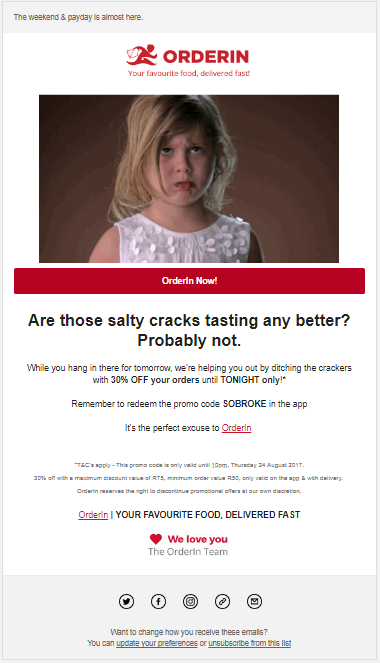What to do when Sales hands
Sometimes a lead hits SQL status but isn’t ready to convert. If sales send a lead back to marketing...
08 Nov 2017
Trying to figure out why your latest campaign fell flat? Here’s a list of 12 common inbound marketing mistakes and ways to combat them in the future.
Sometimes, at the end of a campaign, we’re left scratching our heads for answers. Why didn’t it work? What went wrong? Marketing campaigns have lots of moving parts and, though each one is different (hopefully!), there are some common reasons for them to fail. Don’t be too hard on yourself though, it happens to all of us and the best way to make sure your next campaign is a success, is to analyse what worked - and didn’t - and why. The secret to excellent inbound marketing is simple: create, test, analyse and repeat.
Here are 12 reasons why your latest marketing campaign might’ve let you down (and how to fix them):
An inbound marketing campaign is like hiking to the top of Mount Everest - you need to put in sufficient preparation time, or you’re not going to achieve your goal.

Never research from behind a desk. Immerse yourself in your (or your client’s) brand and industry. When planning an inbound marketing campaign, you need to have your ear to the ground constantly. Are there any quirks that make your brand stand out from the competition? Do you have a strong sense of company culture? When you open yourself up, ideas will find you - and these quirks can truly bring your campaign to life.
Talk to other departments, have brainstorming sessions, and ask your sales team for help. Sales are out in the field with your existing and prospective customers on a daily basis. Pick their brains for content ideas that help answer the questions they get asked, or address topics which help them overcome objections. Talk to your customers, they’ll also have key insights to share. During the research phase, gather as many conflicting opinions as possible. Identify trends.
Research might seem luxury - taking up precious time and resources, but it’s actually a marketer’s best friend.
For some help planning ahead download our Marketing Calendar.
One of the biggest marketing mistakes you can make is to create content without knowing who you’re creating it for (and why).

Identifying your ideal customer (buyer persona) is one of the most important elements to any marketing campaign. If you haven’t identified a buyer persona, or your buyer persona is incorrect, it’ll be extremely difficult to run a successful campaign.
Once you’ve done your research and you’ve collected data about your existing customers, you can create a semi-fictional representation of your ideal customer and start to understand things like their interests, challenges, habits, aspirations, pain points and purchasing behaviour. This will dictate the angle of your campaign, the format of the content you create and the channels which you choose to distribute your content (e.g. LinkedIn vs. Instagram).
Remember:
If your message doesn’t speak directly to your buyer persona’s needs and pain points, your audience won’t engage with your content. By knowing what your audience needs, and how they like to receive information, you can create messages that resonate with them - increasing your engagement and conversion rates.
Make sure you’re sending the right message, to the right person at the right time, within the right context. There’s no magical formula for successful marketing - but if you can get this right, you’ll have the next best thing!
Your content needs to offer your audience solutions based on their current stage of the journey. It’s not about what you want them to hear, it’s about what they’re ready to hear.
The buyer’s journey is there to guide your content strategy. It helps you stay relevant. It protects you from creating spam, or bombarding customers with messages that are too strong, too early on, which send your audience packing. Inbound marketing is about nurturing your customers until they are ready to buy. Stick to the 80/20 rule when planning your content: 80% should be informative, educational and entertaining, and only 20% should talk about your brand.
Automation is great - but make sure that your content is smart and human.

The best marketing strategies use personalisation (with restraint) to avoid sounding like your email was sent by R2D2.
Don’t create email campaigns filled with 17 different generic emails. If you send too many emails, you run the risk of your audience unsubscribing - or, even worse, flagging you as spam (a very hard place to recover from).
Stick to three or four max, and make sure they sound like they came from a person - and not a machine. Use small personalisations, like your contact’s name in an email - a human touch can go a long way towards increasing your response rate. Make sure you have catchy, engaging subject lines that tempt your readers to open the emails. Don’t be afraid to be chatty and casual - make them laugh, use GIFs, use emojis - all of these things make your brand memorable and relatable.
Remember to keep that buyer’s journey in mind - don’t go sending a brand new contact, in the awareness phase, a message that contains too many personalisations. You don’t want to come across like a creepy stalker either!
Here’s one of my favourite examples, from OrderIn:

I’ll always remember OrderIn, and always open their mails - because they make my day. One of the key things to remember when running an email campaign, is that you need to send emails that you'd like to receive.
If you set yourself deadlines that are too short, you’re setting yourself up for failure. When you rush, you forget important steps - leaving you open to costly mistakes. On the other hand, when your deadline is a vague, some-time in the future, you’ll lose focus and forget why the campaign was relevant. You need to set yourself a “Goldilocks” deadline - not too hot, not too cold, but just right.
To do this, make sure you set SMART goals for your marketing campaigns. These are goals which are specific, measurable, achievable, realistic and timely. The best way to make sure that you’ve given your campaign enough time to succeed (without being too open ended) is to start with the end result in mind and work backwards from there. Give yourself a list of small, achievable goals along the way so that you can ensure your campaign is on the right track.
We spend 30% of our budget on radio, 50% on print, 15% on TV and 5% on social media for every campaign because that’s how we do things: this is what a budget oriented campaign looks like. Your campaigns will be more successful if you tailor your budget to suit the goals of the campaign instead of the other way around.
If you’re trying to increase traffic to your website, maybe your budget needs to be focused more on social media and PPC advertising - driving people to your website. Research and data will help you identify where to spend your budget - there’s no cookie cutter budget template for maximum ROI.
You need to tell people what to do next. If your content is missing a clear call to action they won’t understand what their logical next step should be. By inserting clear calls to action, you’ll make your content more engaging and people will be more likely to understand its purpose.
Your CTA must also be relevant to the buyer’s journey. You can’t use a decision phase CTA, like contact us, on every page. You need to have soft CTAs, like subscribe to our blog, in the awareness phase - allowing you to convert your visitors into contacts which can be nurtured into leads.
Tips for creating engaging CTAs:
- Use action-oriented language and make sure it resonates with your persona
- Hook them with a taster of what they’ll receive if they take the action.
- A/B testing is a great way to establish what your audience likes.
If you use an old, outdated or illegally purchased database you put your entire campaign at risk. Don’t do it. Don’t even think about doing it. Make sure you use up to date, organic databases that give you the best chance to reach an engaged audience who won’t report you as spam. If you’re not sure of the quality of your database, run it through a program like BriteVerify to find out which contacts are active and which need to be removed.
Creating great content is the first half of the equation, but if you haven’t promoted this content effectively people won’t be able to find it. Distribution is an integral part of your campaign strategy so make sure you include a social media strategy, and email strategy and possibly paid content promotions when you’re planning your campaign. Make sure that all your messages are consistent across social media platforms, on your website, your blog, in your print advertising etc. You’ll need to carefully plan your content and distribution channels and make sure that you publish good quality content across all platforms consistently. And finally, don’t only promote your content once-off - keep remarketing and distributing your content every couple of months - with the right distribution strategy, you’ll be generating leads for years to come.
If your sales and marketing teams don’t have a common definition of things like marketing vs. sales qualified leads, they’re effectively speaking two different languages. This often boils down to finger pointing, with both teams accusing the other for the failure to convert leads. This creates a negative and unproductive atmosphere for everyone. 
By aligning sales and marketing, and creating good clear communication between both departments, your marketing will be more effective. Your sales team will be able to feed pertinent information to your marketing department, and in turn, marketing can help nurture leads all the way through the sales process - enabling your sales team to close more deals. (For tips on how to achieve marketing and sales alignment, read Darren Leishman’s post, How to align sales and marketing)
When something isn’t working, change course. Don’t wait until the end of your campaign and say “oh dear, those results weren’t at all what we expected”.
Like I mentioned before - inbound marketing is like hiking to the top of Mount Everest. If the weather turns on you, go back to camp and regroup. If you find your path blocked by a rock, find another way around. Sometimes minor tweaks can take a disappointing campaign to new heights - achieving even better results than expected. You won’t know unless you try.
Before you declare your latest campaign a complete failure, make sure you’re not being too hard on yourself! Very often we’re not looking at a big enough picture when it comes to analysing the data and success metrics. If your goal was to increase your conversion rate, and you feel like this wasn’t the case, check for other metrics which could’ve benefited positively from your campaign. For example, perhaps your campaign generated more traffic to your website, or gained you more followers on social media. This could be an indication that your campaign has raised brand awareness, which may still translate to conversions at a later stage. Always keep the big picture in mind!
The most important lesson in business (especially in marketing) is this: don’t dwell on your failures. Nobody succeeds 100% of the time. This is the perfect opportunity to hit the drawing board, analyse what worked and what didn’t, and find ways to tweak your campaign for better results next time.
If you're looking for some help creating marketing campaigns that work, get in touch with us today and we'll help you take your marketing to the next level.
Sometimes a lead hits SQL status but isn’t ready to convert. If sales send a lead back to marketing...
Take a look at some common myths about the buyer's journey and lead nurturing, and how you can...
Buyer Personas are the lodestone of successful inbound marketing, but done badly, they can cause...
Smarketing might sound like a silly portmanteau, but aligning your sales and marketing strategy is...
Be the first to know about new B2B SaaS Marketing insights to build or refine your marketing function with the tools and knowledge of today’s industry.